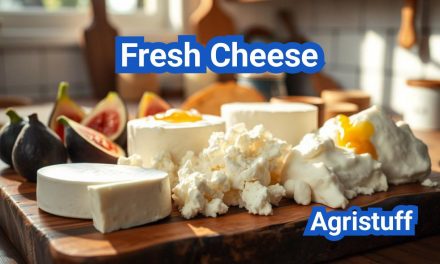A type of cheese produced with pasteurized cow’s, sheep’s, or goat’s milk and ripened with cultures of the mold penicillium, blue cheese has a distinctive veiny appearance and strong flavor that has captivated cheese enthusiasts for centuries.
The rich history of this cheese dates back to the Middle Ages, with various types emerging over time, each with its unique characteristics and production methods.
From its origins to its modern-day applications, blue cheese has become a staple in many cuisines, offering a range of nutritional benefits and culinary uses.
Key Takeaways
- Blue cheese is a type of cheese ripened with cultures of the mold penicillium.
- It has a distinctive veiny appearance and strong flavor.
- Various types of blue cheese have emerged over time, each with its unique characteristics.
- Blue cheese offers a range of nutritional benefits and culinary uses.
- Its rich history dates back to the Middle Ages.
The Fascinating World of Blue Cheese
With its bold flavors and rich textures, blue cheese continues to fascinate and intimidate food enthusiasts alike. This unique category of cheese has been a part of various cultures around the world, with different regions having their unique versions.
What Defines a Blue Cheese
Blue cheese is defined by the presence of blue-green veining, which is a result of the introduction of a type of mold, typically Penicillium roqueforti. This mold gives blue cheese its characteristic appearance and contributes to its strong flavor.
The process of creating blue cheese involves allowing the cheese to age, during which the mold grows within the cheese, creating the distinctive veining. The type of milk used, whether it’s from cows, sheep, or goats, also plays a significant role in the final flavor and texture of the cheese.
Cultural Significance Across Continents
Blue cheese has a rich cultural significance across different continents. In Europe, it is a staple in many cuisines, with countries like France and Italy producing some of the world’s most renowned blue cheeses, such as Roquefort and Gorgonzola.
In America, blue cheese is often used in salads and as a dressing, showcasing its versatility in modern cuisine. The cultural significance of blue cheese extends beyond its taste, representing a tradition of cheesemaking that has been passed down through generations.
The Distinctive Blue-Green Veining
The blue-green veining in blue cheese is not just aesthetically pleasing; it is a result of the careful introduction of mold during the cheesemaking process. This veining is responsible for the cheese’s pungent flavor and is a key characteristic that defines blue cheese.
The appearance of the veining can vary depending on the type of blue cheese, with some having a more pronounced veining than others. This variation contributes to the diversity within the category of blue cheese, making each type unique.
The Origins and Evolution of Blue Cheese
Legend has it that blue cheese was first discovered by chance, when a cheesemaker left a wheel of cheese in a damp cave. This accidental discovery is said to have occurred centuries ago and marks the beginning of blue cheese’s rich history.
The Accidental Discovery Legend
The story of blue cheese’s discovery is often attributed to a cheesemaker who forgot about a wheel of cheese stored in a cave. The damp conditions and unique mold spores in the cave caused the cheese to develop the characteristic blue-green veining that blue cheese is known for today. This fortuitous accident led to the creation of one of the world’s most distinctive and beloved cheeses.
Historical Development Across Europe
As trade and cultural exchange flourished across Europe, the production of blue cheese spread to various regions. Each area developed its unique variety, influenced by local conditions and traditions. For instance, the Roquefort region in France became famous for its blue cheese, which was later granted protected designation of origin (PDO) status. Similarly, other European countries developed their own versions, contributing to the rich diversity of blue cheeses available today.
From Traditional to Modern Production
The production of blue cheese has evolved significantly over time. Traditional methods involved aging cheese in natural caves, where the unique conditions contributed to the cheese’s distinctive flavor and appearance. Modern production techniques have introduced controlled environments that allow for more consistent quality and safety. Despite these advancements, many producers still adhere to traditional methods, valuing the unique characteristics they impart to the cheese. The balance between tradition and innovation continues to shape the world of blue cheese.
Understanding Penicillium Roqueforti: The Magic Behind Blue Cheese
At the heart of blue cheese lies Penicillium roqueforti, a fungus that not only affects its appearance but also its taste and aroma. This mold is responsible for the characteristic blue-green veining that is a hallmark of blue cheeses.
What Is Penicillium Roqueforti
Penicillium roqueforti is a type of fungus that belongs to the Penicillium genus. It is a saprotrophic mold that is commonly found in soil and decaying organic matter. In the context of blue cheese production, Penicillium roqueforti is intentionally introduced into the cheese to induce the formation of its characteristic veins.
How It Creates Blue Veining
The introduction of Penicillium roqueforti spores into the cheese curd leads to the growth of the mold within the cheese’s matrix. As the mold grows, it breaks down the fats and proteins, producing compounds that contribute to the cheese’s flavor and aroma. The veins appear as the mold grows along the paths created by the cheese’s internal structure or through deliberate piercing of the cheese rind.
“The veining in blue cheese is not just aesthetically pleasing; it’s a result of the biochemical processes driven by Penicillium roqueforti.”
Natural vs. Laboratory Cultures
Traditionally, blue cheese producers relied on natural environments to introduce the necessary molds into their cheeses. Modern production often utilizes laboratory-cultivated Penicillium roqueforti strains, which offer more consistency and control over the final product. While both methods are used, laboratory cultures are preferred for their reliability and safety.
Safety of Blue Cheese Molds
The safety of consuming Penicillium roqueforti has been a topic of interest. This mold is generally recognized as safe (GRAS) by regulatory bodies worldwide. However, it’s crucial to handle and store blue cheese properly to prevent contamination by other, potentially harmful molds.
Famous Blue Cheese Varieties From Around the World

From the caves of France to the farms of America, blue cheese has evolved into various celebrated types that tantalize the taste buds. The diversity in blue cheese is a result of different milk types, production methods, and aging processes.
French Blue Cheeses
France is renowned for its blue cheeses, with Roquefort Cheese being one of the most famous. Made from sheep’s milk, Roquefort is aged in the Combalou caves of Roquefort-sur-Soulzon, giving it a distinctive flavor and texture.
Other notable French blue cheeses include Fourme d’Ambert and Gournay, each with its unique characteristics and production regions.
Italian Blue Cheeses
Italy boasts its own array of blue cheeses, with Gorgonzola Cheese being a standout. Gorgonzola is made from cow’s milk and is known for its creamy texture and tangy flavor, available in both sweet and sharp varieties.
Franciacorta is another Italian blue cheese, showcasing the country’s versatility in blue cheese production.
British Blue Cheeses
The UK is home to several esteemed blue cheeses, with Stilton Cheese being one of the most prestigious. Stilton is known for its rich, buttery flavor and is often served as a dessert cheese.
Other British blue cheeses include Shropshire Blue and Oxford Blue, each with its own unique flavor profile.
American Blue Cheeses
America has developed its own blue cheese culture, with varieties like Maytag Blue gaining international recognition. Maytag Blue is known for its sharp, tangy flavor and is produced in Iowa.
| Blue Cheese Variety | Country of Origin | Milk Type | Notable Characteristics |
|---|---|---|---|
| Roquefort | France | Sheep’s milk | Distinctive flavor, aged in Combalou caves |
| Gorgonzola | Italy | Cow’s milk | Creamy texture, tangy flavor |
| Stilton | UK | Cow’s milk | Rich, buttery flavor |
| Maytag Blue | USA | Cow’s milk | Sharp, tangy flavor |
Stilton vs. Roquefort: A Comparative Analysis
In the realm of blue cheeses, Stilton and Roquefort stand out as paragons of distinct production methods and flavor profiles. Both cheeses have garnered international acclaim, yet they embody the unique characteristics of their regions and production techniques.
Production Methods and Regulations
Stilton and Roquefort are both protected by law, with Stilton being a product of Derbyshire, Leicestershire, and Nottinghamshire in England, and Roquefort originating from the Roquefort-sur-Soulzon region in France. The production of Stilton involves a meticulous process where the curd is inoculated with Penicillium roqueforti, then pierced to allow air to reach the curd, fostering the development of its characteristic veining. Roquefort, on the other hand, is made from sheep’s milk and aged in the natural limestone caves of Roquefort-sur-Soulzon, where it develops its distinctive flavor and texture.
The regulations surrounding these cheeses are stringent. For instance, to be labeled as “Stilton,” the cheese must be produced within the designated area and adhere to traditional methods. Similarly, Roquefort’s production is governed by the Appellation d’Origine Protégée (AOP) laws, ensuring that only cheeses aged in the specific caves of Roquefort-sur-Soulzon can bear the name.
Flavor and Texture Profiles
The flavor profiles of Stilton and Roquefort are markedly different. Stilton is known for its rich, buttery flavor with a tangy, slightly sweet aftertaste. The texture is typically crumbly, with a moist, open texture that allows the flavors to meld together. Roquefort, with its sheep’s milk base, has a sharper, more pungent flavor, often described as salty and slightly sweet, accompanied by a creamy texture.
Culinary Applications
Both Stilton and Roquefort are versatile cheeses that can be used in a variety of culinary applications. Stilton is often served as a dessert cheese, paired with fruits and crackers, or used in salads and sauces. Roquefort, with its robust flavor, is commonly crumbled over salads, used as a dressing, or served as a complement to fruit and bread.
Cultural Significance
Stilton and Roquefort hold significant cultural and historical value in their respective countries. Stilton has been a staple of English cuisine since the 18th century, often served at special occasions. Roquefort, with its roots dating back to the Roman era, is a symbol of French fromagerie and is celebrated during local festivals.
| Characteristics | Stilton | Roquefort |
|---|---|---|
| Milk Source | Cow’s milk | Sheep’s milk |
| Production Area | Derbyshire, Leicestershire, Nottinghamshire | Roquefort-sur-Soulzon |
| Flavor Profile | Rich, buttery, tangy | Sharp, pungent, salty |
| Texture | Crumbly, moist | Creamy |
| Culinary Use | Dessert cheese, salads, sauces | Salads, dressings, fruit, bread |
Step-by-Step Blue Cheese Processing

Blue cheese processing is a multi-step journey that requires precision and patience. The production of blue cheese involves several critical stages, from the initial milk selection to the final salting and piercing.
Step1: Milk Selection and Preparation
The journey to creating exquisite blue cheese begins with the selection of high-quality milk. The milk used can be from cows, sheep, or goats, each imparting unique characteristics to the cheese. The milk is then pasteurized or left raw, depending on the type of blue cheese being produced. Adding a starter culture to the milk initiates the fermentation process, converting milk sugars into lactic acid.
Step2: Curd Formation and Cutting
After the milk has been cultured, rennet is added to induce curd formation. The curd is then cut into small pieces to release whey and create a smooth, even texture. The size of the curd pieces can vary depending on the specific type of blue cheese being made.
Step3: Draining and Molding
The curds are then transferred to a mold, where they are allowed to drain excess whey. The molding process gives the cheese its desired shape. Traditional blue cheeses often have a distinctive shape, such as the cylindrical form of Roquefort.
Step4: Salting and Piercing
Once the cheese has been molded, it is salting to enhance flavor and aid in the development of the characteristic blue-green veining. The final step involves piercing the cheese with stainless steel needles to introduce oxygen, which encourages the growth of Penicillium roqueforti, the mold responsible for the cheese’s distinctive veining and robust flavor.
By carefully following these steps, cheesemakers can produce a wide range of blue cheeses, each with its unique flavor profile and texture.
Essential Equipment for Blue Cheese Production

To produce high-quality blue cheese, cheesemakers need specific equipment, which varies depending on whether the production is commercial, artisanal, or for home use. The right equipment is crucial for achieving the characteristic veining and flavor of blue cheese.
Commercial Production Equipment
Commercial blue cheese production involves large-scale equipment designed for efficiency and consistency. This includes:
- Large Cheese Vats: For culturing and curdling milk on a large scale.
- Cheese Molds: Specifically designed to shape the cheese and facilitate draining.
- Aging Facilities: Controlled environments for aging the cheese to develop its characteristic flavor and texture.
- Piercing Machines: Used to introduce oxygen into the cheese, promoting the growth of Penicillium roqueforti.
Artisanal Cheesemaking Tools
Artisanal cheesemakers often use traditional tools that allow for a more personalized and nuanced production process. Key tools include:
- Handheld Cheese Molds: For shaping and draining smaller batches of cheese.
- Wooden Aging Boards: For aging cheese in a controlled, natural environment.
- Cheese Wire: For cutting curds to the desired size.
- Aging Caves or Cellars: Natural or controlled environments for aging cheese.
Home Cheesemaking Supplies
For those making blue cheese at home, the equipment is more accessible and simpler. Essential supplies include:
- Large Pot: For heating and culturing milk.
- Cheese Mold: A smaller version for shaping the cheese.
- Cheesecloth or Butter Muslin: For draining and wrapping the cheese.
- Aging Container: A controlled environment for aging the cheese, such as a refrigerator or a dedicated cheese aging fridge.
The following table summarizes the key equipment for different scales of blue cheese production:
| Equipment Type | Commercial Production | Artisanal Cheesemaking | Home Cheesemaking |
|---|---|---|---|
| Cheese Vats/Molds | Large cheese vats and molds | Handheld cheese molds | Large pot and small cheese mold |
| Aging Facilities | Controlled aging facilities | Wooden aging boards and caves | Aging container or refrigerator |
| Piercing Tools | Piercing machines | Manual piercing tools | Skewer or similar tool |
How to Make Blue Cheese at Home

With the right ingredients and equipment, you can successfully make blue cheese at home. This process involves several key steps, from preparing the milk to aging the cheese.
Ingredients You’ll Need
To start, you’ll need high-quality milk, cheese cultures, rennet, salt, and Penicillium roqueforti spores. The type of milk you choose (cow, sheep, or goat) will affect the flavor and texture of your blue cheese.
- 1 gallon of milk
- 1/4 tsp mesophilic cheese culture
- 1/4 tsp Penicillium roqueforti culture
- 1/4 tsp liquid rennet
- 1 tsp salt
Equipment Preparation
Proper equipment preparation is crucial for making blue cheese at home. You’ll need a large pot, cheese mold, cheesecloth, and a aging refrigerator or cheese cave.
Step1: Preparing and Culturing the Milk
Begin by heating the milk to 86°F (30°C), then add the mesophilic cheese culture and Penicillium roqueforti spores. Allow the milk to culture for about 45 minutes.
Step2: Forming and Cutting the Curds
After culturing, add rennet to the milk and let it coagulate. Once set, cut the curds into 1/2-inch pieces to release whey. This step is critical for developing the cheese’s texture.
By following these steps and using the right ingredients and equipment, you can create a delicious blue cheese at home. The key is patience and attention to detail throughout the process.
Cave-Aging: The Traditional Method for Blue Cheese

For generations, cheese makers have relied on cave-aging to cultivate the characteristic veining and robust flavors of blue cheese. This traditional method involves storing the cheese in controlled environments, allowing it to mature and develop its distinctive taste and texture.
Natural Cave Environments
Natural caves have long been used for aging blue cheese, providing a consistent cool temperature and high humidity that fosters the growth of beneficial molds. The unique conditions within these caves contribute to the development of complex flavors and textures that are highly prized by cheese aficionados.
“The natural caves of Roquefort, France, are renowned for their role in producing some of the world’s finest blue cheeses,” notes a cheese expert. “The specific conditions within these caves are impossible to replicate exactly, making the cheeses produced there truly unique.”
Modern Aging Facilities
While natural caves remain highly valued, modern aging facilities have been developed to replicate the conditions necessary for cave-aging. These facilities use advanced climate control systems to maintain the precise temperature and humidity levels required for optimal aging.
Modern aging facilities offer several advantages, including greater control over the aging process and the ability to produce larger quantities of cheese. However, some argue that the character of the cheese can be affected by the more uniform conditions.
How Cave-Aging Affects Flavor Development
Cave-aging plays a crucial role in the development of blue cheese’s characteristic flavor. The slow, controlled aging process allows the cheese to develop a rich, pungent taste that is both complex and nuanced.
The process of cave-aging contributes to the breakdown of fats and proteins within the cheese, resulting in the formation of compounds that give blue cheese its distinctive flavor and aroma. The length of time that the cheese is aged can significantly impact its final flavor profile.
Famous Cave-Aged Blue Cheese Varieties
Several varieties of blue cheese are renowned for their cave-aged characteristics. Roquefort, for example, is a French blue cheese that is aged in the natural caves of Roquefort-sur-Soulzon. Other notable examples include Stilton from England and Gorgonzola from Italy, both of which have their own unique aging processes.
These famous cave-aged blue cheeses are celebrated for their rich flavors and textures, which are developed through the careful application of traditional aging techniques.
Blue Cheese Nutrition and Health Aspects

Blue cheese is not only a culinary delight but also a nutrient-dense food that offers various health benefits when consumed in moderation. Its nutritional profile is characterized by a rich content of macronutrients, vitamins, and minerals.
Macronutrients and Caloric Content
Blue cheese is known for being high in calories and fat, primarily due to its rich milk source and the cheese-making process. A typical serving of blue cheese (about 28g or 1 ounce) can contain around 100 calories, with a significant portion coming from fat. However, it’s also a good source of protein, which is essential for muscle repair and overall health.
The macronutrient breakdown of blue cheese can vary depending on the type and production methods, but generally, it is high in fat and moderate in protein. Here’s a general overview of what the nutritional content might look like for a typical blue cheese:
| Nutrient | Amount per 28g serving |
|---|---|
| Calories | 100 |
| Total Fat | 8g |
| Protein | 6g |
| Calcium | 200mg |
Vitamins and Minerals Profile
Blue cheese is a rich source of various vitamins and minerals, including calcium, phosphorus, and vitamins A and K. Calcium is crucial for bone health, while phosphorus plays a key role in the formation of bones and teeth, among other functions. Vitamins A and K are important for vision, immune function, and blood clotting.
Potential Health Benefits
The consumption of blue cheese, in moderation, may offer several health benefits due to its nutrient-dense profile. The presence of probiotics in blue cheese can support gut health, while its high calcium content can contribute to stronger bones. Additionally, the antioxidants and other compounds found in blue cheese may help in reducing inflammation and improving overall health.
Considerations for Special Diets
While blue cheese can be part of a healthy diet for many, there are certain considerations for individuals with specific dietary needs or restrictions. Those with high blood pressure or heart disease may need to limit their intake due to its high sodium and fat content. Additionally, individuals with lactose intolerance may need to approach blue cheese consumption with caution, although some find that the aging process reduces lactose levels.
In conclusion, blue cheese offers a complex nutritional profile that includes a range of macronutrients, vitamins, and minerals. When consumed in moderation, it can be a valuable part of a balanced diet, offering potential health benefits while also requiring consideration for those with specific dietary restrictions.
Specialty Blue Cheese Varieties

Beyond the classic types, specialty blue cheese varieties offer unique flavor profiles and textures. These cheeses cater to diverse tastes and preferences, showcasing innovative approaches to traditional blue cheese production.
Organic Blue Cheese Production
Organic blue cheese is made using organic milk and follows strict organic farming practices. This method avoids the use of synthetic pesticides, herbicides, and fertilizers, appealing to consumers seeking more natural products.
Key characteristics of organic blue cheese production include:
- Use of organic milk from farms that do not use synthetic chemicals
- Adherence to organic farming standards
- Avoidance of genetically modified organisms (GMOs)
Goat and Sheep Milk Blue Cheeses
Blue cheeses made from goat and sheep milk offer distinct flavor profiles compared to those made from cow’s milk. Goat milk blue cheese tends to be tangier, while sheep milk blue cheese is often richer and creamier.
| Milk Type | Flavor Profile | Texture |
|---|---|---|
| Goat Milk | Tangy, slightly sweet | Crumbly |
| Sheep Milk | Rich, creamy, nutty | Soft, spreadable |
Soft Blue Cheeses
Soft blue cheeses are characterized by their creamy texture and mild, spreadable consistency. They are often younger than aged blue cheeses and have a less intense flavor.
Examples of soft blue cheeses include:
- Cambozola: A German blue cheese that combines the creaminess of Camembert with the tanginess of blue cheese
- Gorgonzola Dolce: An Italian blue cheese with a soft texture and sweet, mild flavor
Proper Storage and Safety of Blue Cheese
To enjoy blue cheese at its best, it’s essential to understand how to store it correctly. Blue cheese, with its strong flavor and distinctive veining, requires careful handling to maintain its quality and safety.
Optimal Storage Conditions
Blue cheese should be stored in a cool, humid environment. The ideal temperature for storing blue cheese is between 35°F and 45°F (2°C and 7°C), with a relative humidity of 80% to 90%. This can be achieved by wrapping the cheese in wax paper or aluminum foil and placing it in the refrigerator, ideally in a cheese drawer or a sealed container to maintain humidity.
Key Storage Tips:
- Wrap blue cheese in wax paper or aluminum foil to prevent drying out.
- Store in the refrigerator at a consistent temperature between 35°F and 45°F.
- Maintain high humidity to prevent the cheese from drying out.
Shelf Life Guidelines
The shelf life of blue cheese varies depending on its type and storage conditions. Generally, a well-wrapped blue cheese can last for several weeks to a few months in the refrigerator. It’s essential to check on the cheese regularly for signs of spoilage.
| Blue Cheese Type | Shelf Life |
|---|---|
| Soft Blue Cheeses | 2-4 weeks |
| Semi-Soft Blue Cheeses | 4-6 weeks |
| Hard Blue Cheeses | 2-3 months |
Pasteurized vs. Raw Milk Blue Cheese Safety
The safety of blue cheese can depend on whether it’s made from pasteurized or raw milk. Pasteurization kills harmful bacteria, making pasteurized blue cheese generally safer, especially for vulnerable populations like the elderly, pregnant women, and those with compromised immune systems.
“While raw milk blue cheese can offer more complex flavors, it’s crucial to source it from reputable producers who follow safe production practices.”
Signs of Spoilage vs. Normal Aging
Distinguishing between normal aging and spoilage is crucial for enjoying blue cheese safely. Normal aging may result in a stronger flavor and changes in texture, but the cheese should not develop mold beyond its characteristic veining or emit a foul odor.
Signs of Spoilage:
- Visible mold beyond the characteristic blue-green veining.
- Foul or ammonia-like odor.
- Slime or excessive moisture on the surface.
Culinary Uses of Blue Cheese

The bold character of blue cheese makes it a favorite among chefs and home cooks alike for adding depth to numerous recipes. Its distinctive flavor and texture can elevate a variety of dishes, making it a versatile ingredient in many cuisines.
Blue Cheese in Appetizers and Salads
Blue cheese is often used in appetizers and salads to add a pungent flavor. It pairs well with sweet ingredients like figs and pears, creating a balanced taste experience. In salads, crumbled blue cheese can be mixed with greens, nuts, and fruits for a refreshing and savory dish.
Main Course Applications
In main courses, blue cheese can be used to create rich and creamy sauces to accompany meats and vegetables. It’s also a popular topping for steaks and burgers, adding a bold flavor. Blue cheese-stuffed chicken breasts or pork chops are other creative ways to incorporate this cheese into main dishes.
Classic Blue Cheese Dressing Recipe
A classic use of blue cheese is in salad dressings. To make a simple blue cheese dressing, combine crumbled blue cheese, mayonnaise, sour cream, and lemon juice. Adjust the amount of blue cheese to taste, and add herbs like parsley or chives for extra flavor.
- 1/2 cup crumbled blue cheese
- 1/2 cup mayonnaise
- 1/4 cup sour cream
- 1 tablespoon lemon juice
- Chopped fresh herbs (optional)
Blue Cheese Sauces for Meats and Vegetables
Blue cheese sauces are a delicious accompaniment to grilled meats and roasted vegetables. By melting blue cheese with cream or butter, you can create a rich and indulgent sauce. This sauce can be served over steaks, roasted chicken, or steamed vegetables for an added layer of flavor.
Using blue cheese in various culinary applications not only enhances the flavor of dishes but also adds a touch of sophistication. Whether you’re preparing a simple salad or a complex main course, blue cheese is a versatile ingredient that can elevate your cooking.
Blue Cheese in Professional Culinary Settings
Blue cheese is a staple in many professional kitchens, valued for its bold taste and versatility in culinary applications. Its distinctive veining and robust flavor make it a favorite among chefs looking to add a sophisticated twist to their recipes.
Restaurant Applications
In restaurants, blue cheese is often used to enhance the flavor of various dishes, from appetizers to main courses. It can be crumbled into salads, melted into sauces, or served as a standalone component of a cheese board. The key to using blue cheese effectively is balancing its strong flavor with other ingredients.
Popular Restaurant Uses:
- Salad dressings and marinades
- Sauces for meats and vegetables
- Cheese boards and platters
- Dressings for steaks and burgers
Cheese Board Composition Techniques
Creating an appealing cheese board is both an art and a science. When it comes to featuring blue cheese, there are several techniques to consider. Pairing blue cheese with sweet elements like figs or honey can create a delightful contrast of flavors. Additionally, including a variety of textures, such as crackers or nuts, can enhance the overall experience.
| Cheese Type | Pairing Suggestions | Texture |
|---|---|---|
| Blue Cheese | Fruit preserves, honey | Crackers, nuts |
| Soft Cheese | Bread, fruit | Soft bread, crackers |
| Hard Cheese | Nuts, dried fruit | Almonds, apple slices |
Innovative Uses by Professional Chefs
Professional chefs continually push the boundaries of how blue cheese is used in cooking. From incorporating it into innovative sauces to using it as a topping for unique desserts, the versatility of blue cheese is vast. Chefs also experiment with different types of blue cheese, each offering its own distinct flavor profile.
Examples of innovative uses include:
- Blue cheese ice cream
- Stuffed dates with blue cheese
- Blue cheese and pear tart
Blue Cheese in Modern Gastronomy
In modern gastronomy, blue cheese continues to play a significant role. Its bold flavor is used to add depth to dishes, and its luxurious image makes it a popular choice for high-end culinary experiences. As chefs continue to innovate, we can expect to see even more creative uses of blue cheese in the future.
Embracing the Bold Character of Blue Cheese
Blue cheese is a world of complex flavors and textures, shaped by centuries of tradition and innovation. From its accidental discovery to modern production methods, blue cheese has evolved into a diverse range of varieties, each with its unique character.
The distinctive blue-green veining, courtesy of Penicillium roqueforti, is a hallmark of blue cheese, contributing to its bold, tangy flavor and rich texture. Whether it’s the creamy texture of Gorgonzola or the pungency of Roquefort, blue cheese adds depth and sophistication to various culinary applications.
As we’ve explored, blue cheese is not just a type of cheese; it’s an experience. From cheese boards to sauces, and from appetizers to main courses, blue cheese is a versatile ingredient that can elevate any dish. Its nutritional profile, rich in proteins and calcium, adds to its appeal.
In embracing the bold character of blue cheese, we celebrate not just a food product, but a culture, a tradition, and a community of cheese enthusiasts around the world. Whether you’re a cheesemonger, a chef, or simply a cheese lover, blue cheese has something to offer, making it a timeless favorite in the world of gastronomy.
FAQ
What is blue cheese?
Blue cheese is a type of cheese that has been infested with a type of mold, typically Penicillium roqueforti, which gives it a distinctive veining of blue or blue-green and a strong, pungent flavor.
Is blue cheese mold safe to eat?
Yes, the mold in blue cheese is safe to eat and is a result of a controlled introduction of Penicillium roqueforti during the cheese-making process.
What are the different types of blue cheese?
There are several types of blue cheese, including Roquefort, Stilton, Gorgonzola, and Danish Blue, each with its own unique characteristics and production methods.
How is blue cheese made?
Blue cheese is made by introducing Penicillium roqueforti into the cheese curds during the cheese-making process, followed by a period of aging that allows the mold to grow and develop the characteristic veining.
What is the difference between Stilton and Roquefort?
Stilton and Roquefort are both types of blue cheese, but they have different origins, production methods, and flavor profiles. Stilton is a English blue cheese with a rich, buttery flavor, while Roquefort is a French blue cheese with a sharp, tangy flavor.
How should blue cheese be stored?
Blue cheese should be stored in the refrigerator, wrapped in plastic wrap or aluminum foil to prevent drying out, and kept at a consistent refrigerated temperature.
What are the health benefits of blue cheese?
Blue cheese is a rich source of protein, calcium, and other nutrients, and may have potential health benefits due to its high levels of conjugated linoleic acid (CLA) and other beneficial compounds.
Can blue cheese be made at home?
Yes, blue cheese can be made at home with the right equipment and ingredients, including a cheese-making kit and a controlled environment for aging.
What are some common uses for blue cheese?
Blue cheese is a versatile ingredient that can be used in a variety of dishes, including salads, sauces, dressings, and as a topping for meats and vegetables.
Is blue cheese safe for people with dairy allergies?
No, blue cheese is not safe for people with dairy allergies, as it is made from cow’s, sheep’s, or goat’s milk and contains dairy proteins.
What is the difference between gorgonzola dolce and piccante?
Gorgonzola dolce and piccante are both types of Italian blue cheese, but they have different textures and flavor profiles. Gorgonzola dolce is a creamy, mild blue cheese, while gorgonzola piccante is a stronger, more crumbly blue cheese.
What is penicillium roqueforti?
Penicillium roqueforti is a type of mold that is used to make blue cheese, giving it its characteristic veining and strong flavor.
Can blue cheese be frozen?
While it’s technically possible to freeze blue cheese, it’s not recommended, as freezing can cause the cheese to become crumbly and lose its flavor and texture.
Conclusion of: Blue Cheese
What Is Blue Cheese?
Blue Cheese is a family of mold-ripened cheeses characterized by blue-green veining and a tangy, savory aroma, created when cheesemakers inoculate milk or curd with Penicillium roqueforti or P. glaucum. In U.S. regulation, Blue Cheese has a formal standard of identity that sets expectations for moisture, fat, mold veining, and aging, helping producers and shoppers align on quality and safety for Blue Cheese. eCFR – Blue cheese standard
Why Blue Cheese Is “Blue”
Blue Cheese develops its hallmark veins when oxygen reaches the interior and activates the aerobic mold, which then drives proteolysis and lipolysis that unlock creamy textures and bold flavors. The signature aroma of Blue Cheese arises partly from methyl-ketones formed during ripening, which vary by culture strain, salting, and time. MDPI – Blue cheeses review
A Short History of Blue Cheese
Blue Cheese has centuries of European heritage, with natural caves historically providing the cool, humid microclimates necessary for mold ripening. Regions like southern France, northern Italy, and England nurtured distinct Blue Cheese traditions that modern dairies now reproduce with precise environmental control. Britannica – Blue cheese overview
Roquefort: The French Classic
Among Blue Cheese icons, Roquefort stands out for its sheep’s milk base and aging in the Combalou caves of Roquefort-sur-Soulzon. Its protected status preserves place-based techniques, giving Blue Cheese lovers a benchmark for tang, minerality, and luscious crumble. Britannica – Roquefort
Gorgonzola: Dolce and Piccante
Italian Blue Cheese thrives in two principal styles: Gorgonzola Dolce (mild, creamy) and Gorgonzola Piccante (firmer, spicier). Both are PDO cheeses whose make schedules, piercing patterns, and affinage are fine-tuned to yield the desired Blue Cheese flavor and body. Consorzio Gorgonzola
Stilton: The English Benchmark
Stilton is a cow’s-milk Blue Cheese with a buttery crumble and even veining, protected by a UK PDO code of practice that details draining, sealing, piercing, and maturation. For many palates, Stilton defines balance and depth in Blue Cheese. UK Gov – Stilton PDO specification (PDF)
American Originals: Maytag Blue & Beyond
In the U.S., Maytag Blue—developed in 1941 with Iowa State University—helped establish a homegrown tradition of Blue Cheese. Today, American artisan dairies produce diverse Blue Cheese styles, from creamy wheels to robust, long-ripened wedges. Maytag Dairy Farms – Our Story
Other Blue Cheese Styles
From Denmark’s Danablu to Spain’s powerful cave-aged classics, Blue Cheese encompasses a wide flavor spectrum. Milk type, salting regimes, and pierce-ripen schedules all shape the final profile, letting Blue Cheese express terroir and technique. Qualigeo – Danablu PGI
Milk Selection & Cultures
Whether cow, sheep, or mixed milks, the starting point for Blue Cheese is standardized for fat and protein, then inoculated with starter cultures and Penicillium spores. Culture choice, dose, and timing influence openness, veining, and the peppery aromas prized in Blue Cheese. eCFR – Blue cheese composition
Coagulation & Cutting the Curd
Blue Cheese curd forms when rennet coagulates the milk into a gel that is cut to specific sizes and gently stirred or heated. Target curd size and the handling regime are early levers for moisture, body, and the internal openness that Blue Cheese needs for veining. American Cheese Society – Best Practices (PDF)
Draining, Hooping & Salting
After cutting, Blue Cheese curds are transferred into hoops or molds to drain and knit. Dry salting or brining moderates microbial activity, moisture, and rind development, setting up the balance of savory, sweet, and sharp notes that characterize Blue Cheese. Stilton PDO – Process stages (PDF)
Piercing to Create Veining
To promote internal mold growth, Blue Cheese is pierced with sterile needles or rods to admit oxygen. The number, depth, and timing of piercings help control veining density and intensity, providing a critical “style dial” for Blue Cheese flavor. Journal of Dairy Science – Piercing effects
Ripening (Affinage) & Environment
Blue Cheese typically ripens at cool temperatures with high humidity, while cheesemakers manage flipping schedules, airflow, and surface treatments. Enzymes and molds reshape proteins and fats over weeks to months, converting young Blue Cheese into a creamy, aromatic delicacy. MDPI – Microbiology & sensory of blue cheeses
Food Safety: Pasteurized vs. Raw
For vulnerable groups, pasteurized Blue Cheese is the safer choice because soft cheeses from raw milk can carry higher risk of Listeria monocytogenes. U.S. public-health guidance explains why certain populations should avoid raw-milk Blue Cheese or ensure thorough heating. CDC – Dairy & Listeria
Handling & Serving Safety
Keep Blue Cheese refrigerated, avoid cross-contamination during slicing, and observe use-by dates. Even pasteurized Blue Cheese deserves careful handling—especially for at-risk groups—so follow evidence-based advice when serving Blue Cheese at room temperature or in cooked dishes. FDA – Listeria guidance
Equipment: Vats & Curd Handling
Modern Blue Cheese plants rely on precision cheese vats for consistent coagulation, cutting, and whey separation. Automation helps protect delicate curds so Blue Cheese maintains internal openness for proper veining while meeting rigorous safety and quality goals. Tetra Pak – Cheese vats
Equipment: Piercing & Production Lines
At scale, Blue Cheese needling can be mechanized to deliver uniform oxygen channels across large wheels or blocks. Purpose-built systems improve repeatability and throughput while preserving the artisanal character consumers expect from Blue Cheese. ALPMA – Cheese-making technology
Aging Rooms, Wrapping & Packaging
Dedicated aging rooms for Blue Cheese regulate temperature, humidity, and airflow, while post-ripening wrapping controls moisture and aroma release. These finishing steps protect flavor and texture so Blue Cheese arrives at retail in peak condition. ACS – Aging & hygiene practices (PDF)
Nutrition Snapshot (Per 100 g, Typical)
Blue Cheese is nutrient-dense, commonly delivering ~21 g protein, ~29 g fat, ample calcium, and notable sodium; numbers vary by style and brand. For shoppers planning balanced meals, these benchmarks help right-size servings of Blue Cheese. MyFoodData – Blue cheese nutrition
Buying Blue Cheese in the U.S.
Labels for Blue Cheese often specify milk type, origin, and whether the product follows protected-origin rules (e.g., PDO/PGI for European styles). U.S. cheese standards further define many categories so buyers can compare Blue Cheese options consistently. eCFR – Cheese standards (Part 133)
Storage at Home
To keep Blue Cheese fresh, wrap it in breathable cheese paper or parchment and store inside a covered container in the coldest part of the fridge. Rotate pieces to minimize moisture pooling, and use science-based timelines for ready-to-eat Blue Cheese. FoodSafety.gov – Cold storage chart
Culinary Uses & Pairings
Blue Cheese shines in crumbly salads, creamy dressings, burger blends, steak sauces, and cheese boards with pears, figs, honey, and walnuts. Balance richness with acidity or sweetness, and let Blue Cheese come to room temperature briefly for optimal flavor. Britannica – Culinary notes
Troubleshooting Texture & Flavor
If Blue Cheese tastes metallic or overly sharp, it may be over-ripe or stored too warm; if it’s too tame, seek longer-ripened or more intensely pierced styles. Makers adjust salt, humidity, and piercing patterns to tune Blue Cheese character. MDPI – Process variables & outcomes
Final thought
Blue Cheese is a carefully managed ecosystem where milk chemistry, oxygen, salt, and time interact to produce layered aromas and complex textures. From Roquefort and Gorgonzola to Stilton and American originals, exploring Blue Cheese rewards curiosity—whether you’re crafting wheels in a creamery or plating a weeknight salad. American Cheese Society
Sources & References
- eCFR – 21 CFR §133.106 (Blue cheese)
- MDPI – Blue Cheeses: Microbiology & Sensory
- Britannica – Blue cheese
- Britannica – Roquefort
- Consorzio per la Tutela del Formaggio Gorgonzola
- UK Gov – Stilton PDO specification (PDF)
- Maytag Dairy Farms – Our Story
- Qualigeo – Danablu PGI
- American Cheese Society – Best Practices (PDF)
- Journal of Dairy Science – Piercing & ripening
- CDC – Dairy & Listeria
- FDA – Listeria guidance
- Tetra Pak – Cheese vats
- ALPMA – Cheese-making technology
- MyFoodData – Blue cheese nutrition (USDA-based)
- eCFR – Cheese standards (Part 133)
- FoodSafety.gov – Cold storage charts
- American Cheese Society – Official site










